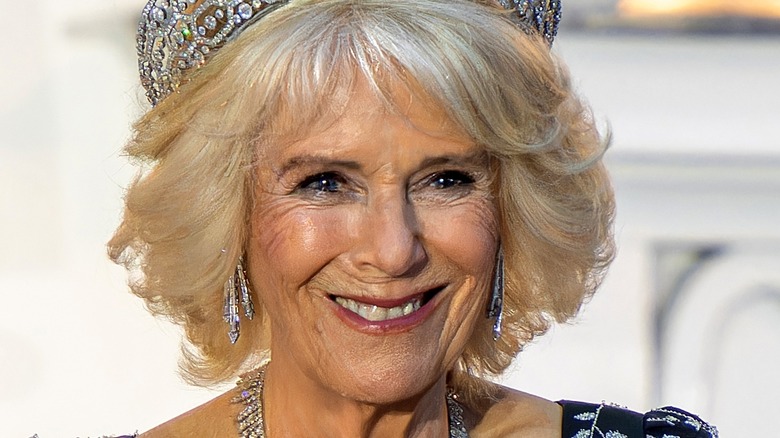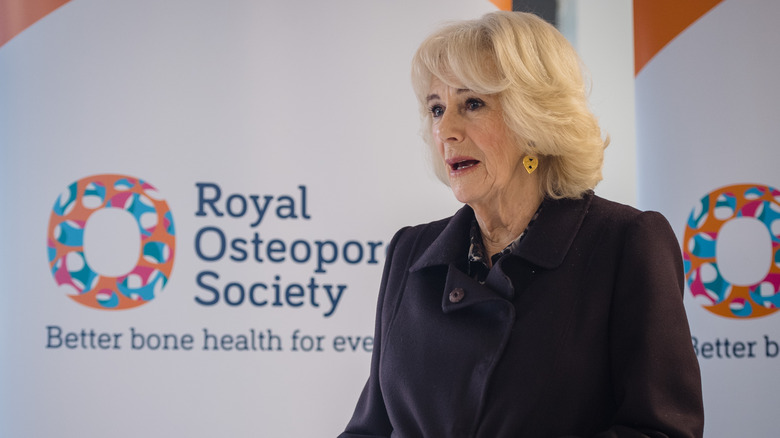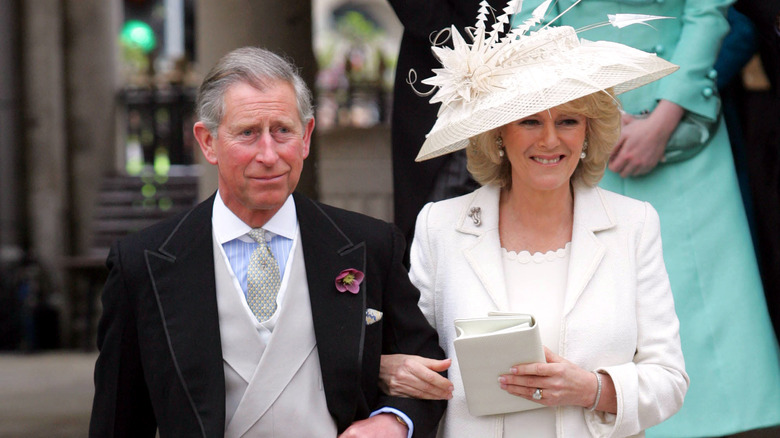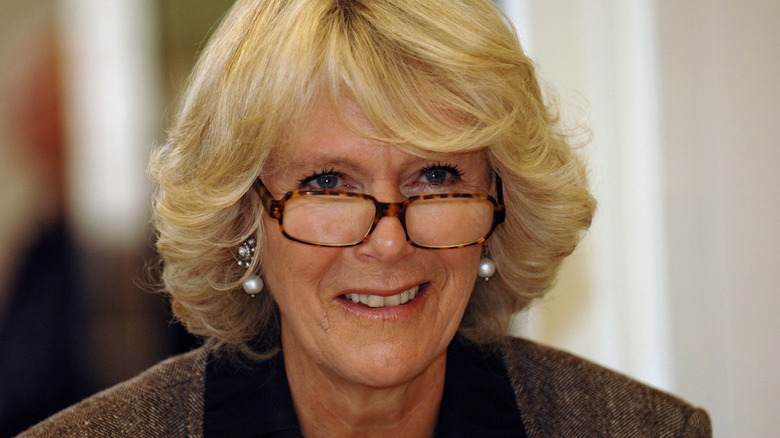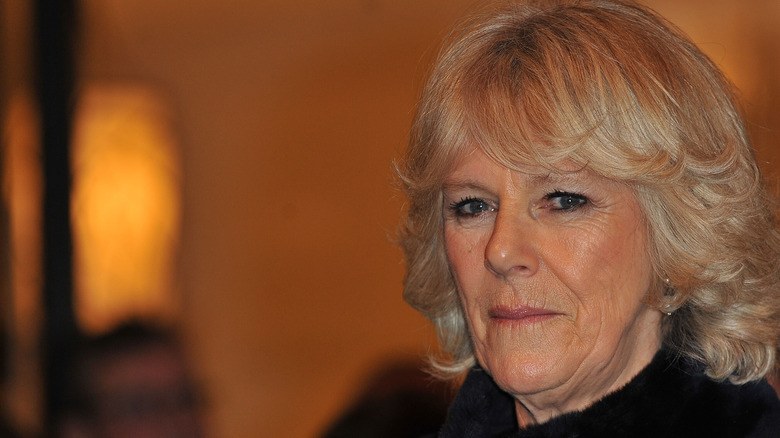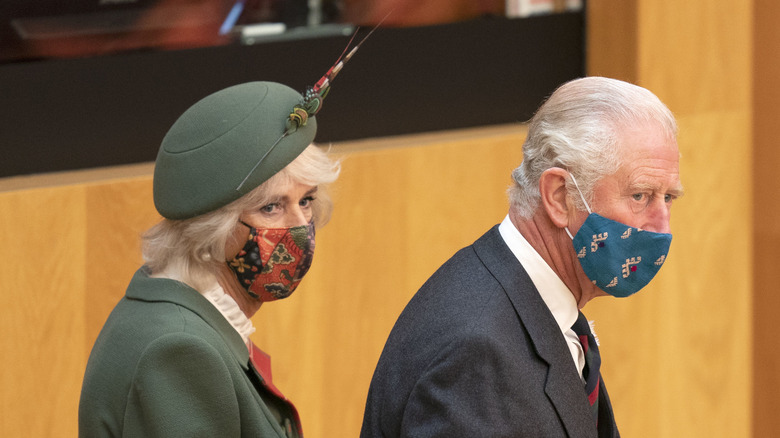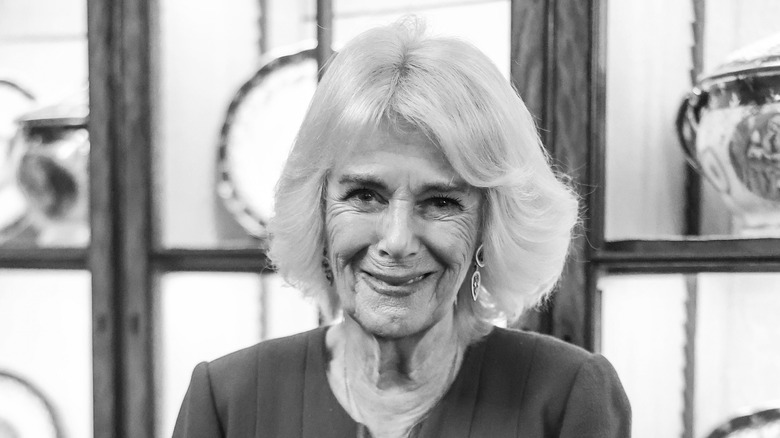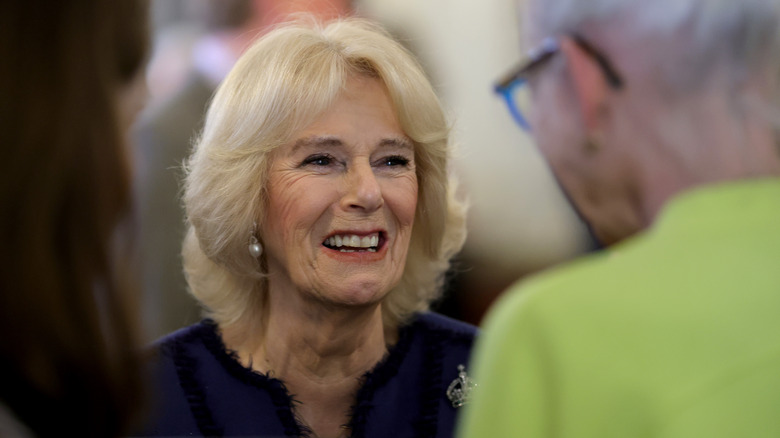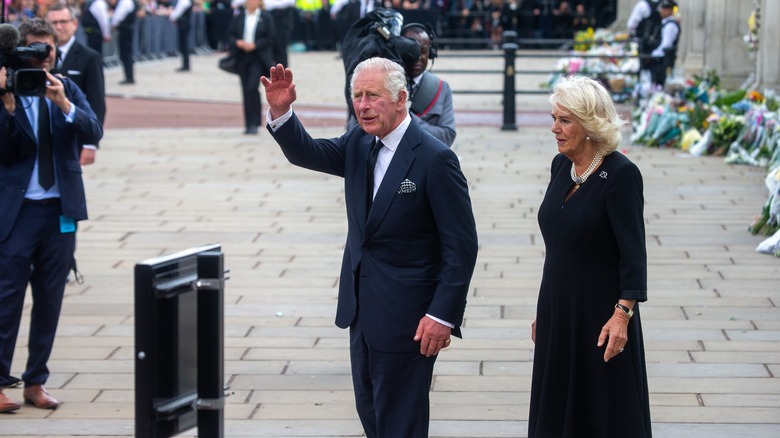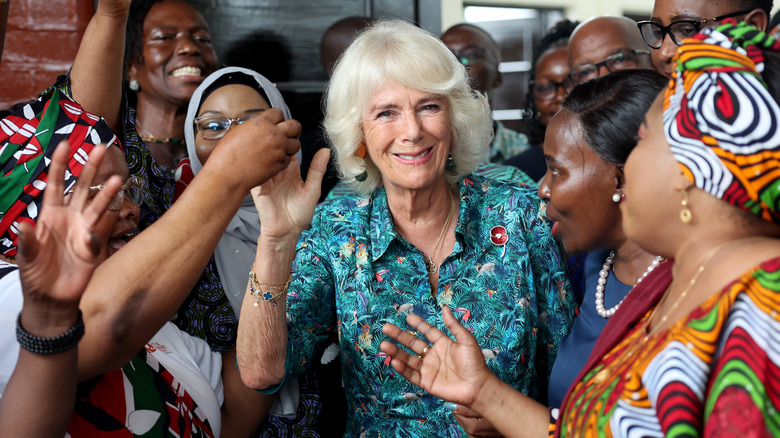Inside All Of Queen Camilla's Health Issues
Queen Camilla has long led an active public life, even before becoming the queen consort upon King Charles III's ascension to the throne. In fact, when she was still the Duchess of Cornwall, the British royal family's website reported that Camilla was a president or patron of nearly 100 charities. Most of these organizations center around key issues Camilla cares about, including health, female empowerment, literacy, and the arts. Interestingly, Camilla's own family health history has influenced some of the patronages she's chosen to support.
Considering the queen consort's advanced age and hectic schedule — plus some worrying symptoms she's experienced while out in public — some people have raised concerns about Camilla's personal health. To get a better understanding of the queen consort's overall health as well as her passion for some of the related causes she's involved with, let's take a look at key moments in her health history.
If Camilla doesn't already have osteoporosis, she is at risk
Queen Camilla has been outspoken about osteoporosis for several years. The issue even inspired some of her earlier charity work, as she sought to increase awareness of the common bone disease that primarily impacts women. In fact, before her role as queen consort, Camilla served as the president of the Royal Osteoporosis Society. According to her profile on the society's official website, Camilla first joined as a donor in 1997 and became the charity's president in 2001.
The queen consort's passion for osteoporosis awareness, prevention, and treatment developed out of a personal and family history of the disease. Camilla's late mother, Rosalind Shand, tragically died from complications of osteoporosis in 1994. Additionally, Camilla's grandmother died from the disease. In a 2019 speech for the Royal Osteoporosis Society, Camilla revealed, "It was 25 years ago that my mother died as a result of osteoporosis. In fact, she was exactly the same age that I am now. Then it was never discussed, rarely diagnosed and always attributed to old people." The queen consort has sought to change this.
While she hasn't confirmed whether she has osteoporosis herself, the Mayo Clinic reports that having a parent or other close relative with the condition increases one's personal risk. However, Camilla does practice yoga and pilates, David Wiener told Express. Both forms of exercise can be helpful in preventing and managing osteoporosis. According to Wiener, he would recommend "people of that age to do" both. He continued, telling the publication, "As you get older, it comes to no surprise you should be doing less strenuous exercise as it could cause muscular pain and your bones become much more fragile."
Queen Camilla has a history of sinusitis
Queen Camilla has reportedly dealt with recurring sinusitis for many years. According to Express, as recently as 2021, the public witnessed Camilla struggling during the annual Armistice Day festivities.
Incidents of Camilla dealing with sinusitis reportedly go back even further than this, with a particularly bad infection making her feel under the weather on the week of her own wedding to then-Prince Charles. In 2012, Camilla had another experience with sinusitis, causing her to cancel numerous engagements and charity events in early October of that year. "The Duchess of Cornwall has developed sinusitis and a severe middle ear infection over the last few days which means she will not be able to carry out her engagements in London this evening and tomorrow," a spokesperson said at the time, as quoted by BBC.
Chronic sinusitis is defined by Harvard Health as "long-term inflammation of the sinuses," with symptoms ranging from months to years. Although it's possible Camilla has recurrent bouts of short-term sinusitis, which typically last weeks at a time. "Patients with a weakened immune system are more prone to getting recurrent acute sinusitis," Dr. Mas Takashima an ENT specialist, told Express. "Sometimes, however, the issue may be anatomy, such as a deviated septum (the wall between the nostrils), scarring from previous sinus surgery, or nasal polyps, which result from chronic inflammation in the nose."
She underwent a hysterectomy in 2007
In early 2007, Queen Camilla had a hysterectomy. According to NBC News, a spokesperson for the then-duchess said that Camilla was scheduled to finish a tour of the Middle East with her husband at the end of February before preparing for surgery. She was also expected to be hospitalized for a few days before and after the surgery, and the recovery timeline was expected to take six weeks.
Camilla, who was 59 years old at the time of the hysterectomy, successfully underwent surgery on March 5. "The Duchess of Cornwall had her operation this morning and is recovering well," a statement from then-Prince Charles read, as reported by CBS News. Camilla's spokesperson said the surgery was not due to cancer, though the exact reasons are unclear.
A hysterectomy may be ordered for numerous reasons in addition to cancer, including abnormal benign growths or menstrual problems. According to the U.K.'s National Health Service, the procedure is most common in women between the ages of 40 and 50.
Camilla fractured her leg in 2010
In 2010, Camilla, Queen Consort, experienced an accident while she and then-Prince Charles were on an Easter holiday getaway. According to The Guardian, Camilla, who was 62 years old at the time, slipped and fell while she was walking outside the couple's estate of Birkhall in Scotland.
A spokesperson for the then-duchess said at the time, "Today, following doctor's advice, Her Royal Highness had an x-ray which showed a twisted fracture of the fibula. Consequently, Her Royal Highness is wearing a plaster cast and will be for six weeks. She has been advised not to put weight on her leg. Her Royal Highness has every intention of carrying out all planned engagements." The incident was also likely even more frightening given Camilla's family history of osteoporosis, which can weaken bones to a point where fractures can easily occur.
Later that year, details emerged that the duchess had been rescued by two women along the trail. As writer Bob Colacello recounted in Vanity Fair, "When ... asked her about breaking a leg in Scotland last fall, [Camilla] explained that she had fallen in a hole while walking the moors and was rescued by two very nice ladies." Camilla reportedly said, "They were so kind. They took me to a hospital and stayed with me the whole time — and not one word to the press! I was so grateful I sent each of them a case of champagne."
She tested positive for COVID-19 in 2022
On February 14, 2022, Clarence House, the residence of then-Prince Charles and Camilla, announced that the couple tested positive for COVID-19. Charles had tested positive just four days before his wife, according to CBS News. At the time, there was concern for 95-year-old Queen Elizabeth II, as she had been in direct contact with her eldest son a few days before he tested positive. While this was Charles' second time experiencing the infection — he first got COVID-19 in March 2020 — this was the first time Camilla tested positive.
The world was entering a third calendar year of the pandemic at the time, and although cases were starting to trend downward in England in mid-February, data from the United Kingdom's Office for National Statistics reported that there were still over 2 million people in England who'd tested positive for COVID-19 that week. Unfortunately, Camilla and Charles were among the ones infected.
The primary variants circulating in the U.K. at the time were Omicron BA.1 and BA.2, though it's not clear which variant affected Camilla or her husband. People previously reported that both Camilla and Charles had received their recommended COVID-19 vaccines, with their first shots administered in February 2021 as the vaccine became available.
Later, Queen Camilla reportedly suffered from long-COVID
When Queen Camilla, then the Duchess of Cornwall, first tested positive for COVID-19 in early 2022, she reportedly did not experience complications. While she was 74 years old at the time, Camilla was vaccinated and arguably had access to some of the best medical care available. However, as time went on, more information was made available about her condition. According to Express, she was actually asymptomatic at the time of her COVID-19 diagnosis, but she experienced what seemed like a delay in symptoms that left her feeling terrible for weeks. "It's taken three weeks and still can't get shot of it," the publication quoted her as saying in March 2022. "Probably my voice might suddenly go, and I might start coughing and spluttering."
Given the severity of her symptoms and the timeline, Camilla was thought to have long COVID. The Centers for Disease Control and Prevention defines long COVID as symptoms that persist for four weeks or longer after the initial infection starts. While there's much more to learn about the symptoms of long COVID and why it develops in some people and not others, the CDC does identify some of the most common signs. These include a chronic cough, like Camilla experienced, as well as significant fatigue and malaise, brain fog, mood changes, and more.
Camilla tested positive for COVID-19 again in 2023
In 2023, Queen Camilla was diagnosed with COVID-19 a second time. Ironically, the announcement of her positive test was announced almost exactly a year after the first time she tested positive for the virus. The first diagnosis was announced on February 14, 2022, and her latest positive test was announced on February 13, 2023. "After suffering the symptoms of a cold, Her Majesty The Queen Consort has tested positive for the COVID virus," Buckingham Palace said in a statement on her behalf, as reported by CBS News. Camilla had to cancel all of her public work so she could self-isolate.
While it was surely disheartening for Camilla to contract COVID-19 a second time within a year, there was some good news — this time, the virus' duration appeared to be much shorter. Just 10 days after Buckingham Palace made the initial announcement about the queen consort's positive test result, Camilla was able to attend her first public event. This event — the launch of a literacy charity effort called The Queen's Reading Room — was held at Clarence House, according to Sky News. "It's a huge pleasure to welcome you all, writers, publishers and book lovers to Clarence House," Camilla was reported as saying at the event. "A week late — but COVID-free."
Camilla was dealing with an injury around the time of Queen Elizabeth II's death
When Queen Elizabeth II died, the royal family entered a state of mourning. This also sent Camilla into a whirlwind schedule of meetings and appearances with other members of the family, world leaders, and the public. "I count on the loving help of my darling wife, Camilla," King Charles III said in his first speech following his mother's death. "In recognition of her own loyal public service since our marriage 17 years ago, she becomes my queen consort. I know she will bring to the demands of her new role the steadfast devotion to duty on which I have come to rely so much."
Indeed, the new queen consort did fulfill her "steadfast devotion to duty" during those hectic days after Elizabeth II's death, all while dealing with another health problem. According to The Telegraph, Camilla, Queen Consort, broke her toe shortly before Elizabeth II died. However, there was no time to wait for it to heal, so it seemed. Despite her fractured toe, Camilla was often on her feet, meeting with the many people who mourned the death of her mother-in-law. A source told the publication, "She is in quite a lot of pain but she is just getting on with it. It is unfortunate timing to say the least but she's been an absolute trouper."
Others also praised the new queen consort for her perseverance, with the Daily Mail even posting on X (formerly known as Twitter), "Camilla puts her best foot forward as she battles through events remembering the Queen with a broken toe."
Queen Camilla's hands raised concerns about her 'physical and mental health'
Camilla, Queen Consort, turned 76 years old in July 2023. Still, she maintains an incredibly full schedule, which includes solo public appearances as well as the duties she shares with her husband, King Charles III. Outside of concerns about the queen consort contracting COVID-19 for a second time in 2023, some raised more general concerns about her health.
In April 2023, Great Britain News reported that Queen Camilla experienced visibly shaking hands while accompanying King Charles to Kenya, where they had four days packed with various engagements. "The impact of Queen Camilla performing such strenuous global tours at her age can put a strain on her physical and mental health," Sarah Campus, an outside nutrition and fitness expert, speculated to Great Britain News at the time. "The duties that the Queen needs to carry out so far from home will certainly increase her levels of stress."
A year earlier, royal watchers noticed Camilla's hands shaking while giving a speech in recognition of International Women's Day, Express reported. While these repeated instances have worried some people, Buckingham Palace has not reported any serious health issues on her behalf, as of this writing. Overall, Camilla appears to be a healthy septuagenarian with a history of health scares and chronic conditions, just like any normal person.
